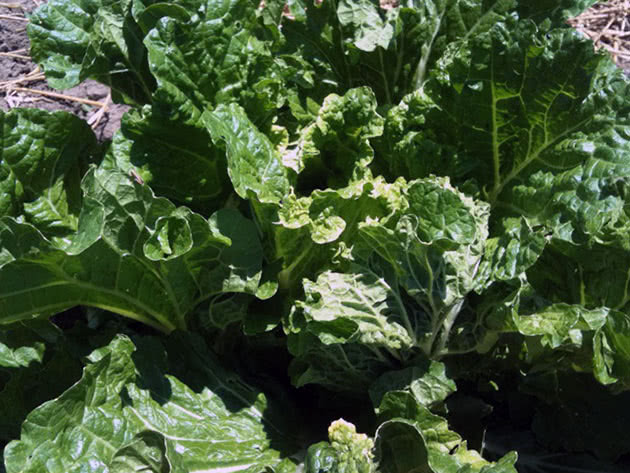Cabbage – planting and care
 Cabbage (lat. Brassica) is a genus of plants of the cabbage family (Cruciferae) that includes such well known cultivars as headed cabbage, turnip, radish, rutabaga and mustard. There are about 50 species of the genus spread in Central Europe, the Mediterranean, Eastern and Central Asia. In America there are only species that were brought from Europe. Cabbage was grown for food by the ancient Egyptians, Greeks and Romans. It began feeding the humanity 4,000 years ago. In Russia cabbage was brought by the merchants from Western Europe during the golden age of Kievan Rus in the XIII century. By the XVIII century it had become a part of the Russian way of life that after the Orthodox feast of the Exaltation, that is celebrated on September 27, a new tradition of collective cabbage harvesting for winter was established.
Cabbage (lat. Brassica) is a genus of plants of the cabbage family (Cruciferae) that includes such well known cultivars as headed cabbage, turnip, radish, rutabaga and mustard. There are about 50 species of the genus spread in Central Europe, the Mediterranean, Eastern and Central Asia. In America there are only species that were brought from Europe. Cabbage was grown for food by the ancient Egyptians, Greeks and Romans. It began feeding the humanity 4,000 years ago. In Russia cabbage was brought by the merchants from Western Europe during the golden age of Kievan Rus in the XIII century. By the XVIII century it had become a part of the Russian way of life that after the Orthodox feast of the Exaltation, that is celebrated on September 27, a new tradition of collective cabbage harvesting for winter was established.
Cabbage was sliced and salted, and during two weeks there were fun folk festivities. In the XIX century a prominent Russian scientist and gardener Ritov determined 22 varieties of headed cabbage.
Description of cabbage plant
Headed cabbage (lat Brassica oleracea) is a biennial plant with high leafy stem, bare gray or bluish-green leaves, grown as a crop. Lower leaves are fleshy, large, lyrate, pinnately dissected, adhering to each other to form the rosette-head around the stem. Upper leaves are oblong and sessile. Large flowers make a multi-flowered brush. Cabbage seeds are also large, dark-brown, spherical, about 0.08 inch long. Cabbage contains mineral salts of calcium, potassium, sulfur and phosphorous, fiber, enzymes, volatile, fats, vitamins A, B1, B6, K, C, P, U, and others. According to some scientists, headed cabbage is from Colchis lowland, where it is still grown in a variety of similar plants, called "kezhera" by locals. Headed cabbage includes such well known species as white and red cabbage, cauliflower, Savoy cabbage, Brussels sprouts, Portuguese cabbage, kohlrabi, broccoli, Pekinensis, Chinensis, and kale.
Growing cabbage from seeds
Sowing cabbage seeds
The quality of cabbage depends first of all on the seed grains, so you should choose the seeds in the most responsible manner and before growing the seedlings of cabbage, you should decide for what purpose and when you want to get harvest – whether you want an early vegetable with tender leaves for salads or strong dense heads of cabbage for winter storage and pickling. It is the purpose that determines your choice of cabbage varieties and the dates of planting. Widely cultivated and very popular among gardeners white cabbage has early season varieties that are suitable only for food in summer, mid-season varieties that can be eaten raw in summer or salted for winter, and late season varieties that are more suitable for long-term storage than any other variety. The sowing of early season varieties of cabbage to grow seedlings is carried out from the first days of March till the third week of the month, the seeds of mid-season varieties are sown after April 25th, and late season cabbage varieties are sown from early April until the third week of the month. Usually seedlings are planted in the open ground in 45-50 days after sowing of seeds.

If you have decided what you wish and purchased the seeds of the necessary varieties, it's time to think about the preparation of soil for planting. Professionals recommend to prepare the soil mixture in autumn to avoid digging out the ingredients from the snow in winter. Mix one part of humus and sod soil, add ash at the rate of 1 tablespoon per 2.2 pounds of soil and mix it well. Ash will act as an antiseptic and a source of macro- and microelements, preventing the blackened stem base of cabbage seedlings. You can prepare a mixture based on peat, for example. The main point is that it should be fertile and breathable. For growing seedlings never use the garden soil from the site where crucifers were grown as it is very likely that it may contain pathogens that can affect the shoots.
Cabbage growing begins from soaking the seeds in water at the temperature of about 122 ºF for 20 minutes, then they are immersed for 5 minutes in cold water to enhance immunity of seeds to fungal diseases. Then the seeds are put in a solution of a growth stimulant for a few hours. However, there are varieties the seeds of which should not get wet – carefully read the instructions attached to the sachet with seeds. Water abundantly the soil before planting and do not moisturize it again until shoots appear. Seeds are sown to a depth of 0.4 inch and then covered with a foil or paper to keep the temperature at 68 ºF and for the moisture not to evaporate from the upper soil layer.
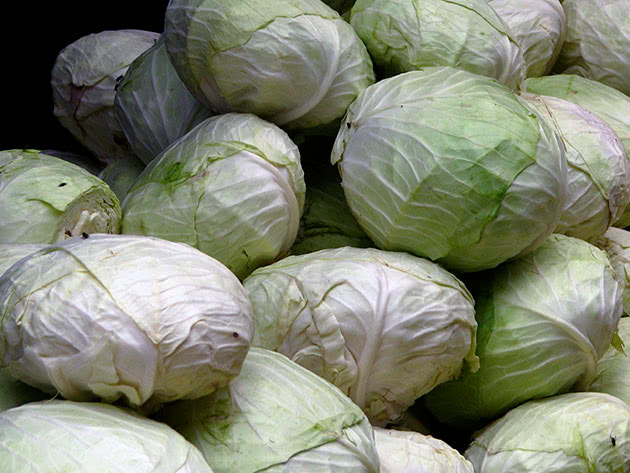
Growing cabbage seedlings
Seedlings appear on the 4-5th day, after that the foil or paper is removed and the temperature is lowered to 43-50 ºF and seedlings are kept under such conditions until the first true leaf appears. It is better to place a container with seedlings on the glazed balcony, and usually it takes a week to achieve the expected result. When the first true leaf appears, the temperature in sunny days is increased to 57-64 ºF, in cloudy days it should be between 57-61 ºF, and at night it should be 43-50 ºF. At this stage care for cabbage seedlings implies plants’ exposure to fresh air and protecting them from the drafts. In addition, seedlings need supplementary lighting of fluorescent lamp: its light day should be at least 12-15 hours a day. Do not let the soil dry out or get waterlogged. A regular loosening of the soil after watering will help you avoid this problem. In a week after shoots appearance the soil is watered with a weak solution of potassium permanganate at the rate of 0.03 oz of potassium permanganate per 2.2 gallons of water or a weak solution of copper sulfate.
Pricking out the seedlings
In 10-14 days after shoots appearance and formation of the first true leaf plants are pricked out, giving the seedlings larger supply area. An hour before the pricking out the cabbage, soil with seedlings is abundantly watered, and then each seedling is removed with a clod of soil and after shortening its root length by one-third, it is planted in individual pot (preferably peat humus), deepening it down to cotyledon leaves. Pricking out can be avoided if initially cabbage seeds are planted in individual containers – when being transplanted into open ground the root system of seedlings is not injured, and by the time of planning in the beds, they will have been rather big. If you grow the seedlings in peat-humus pots, then you can plant the seedlings directly in them.
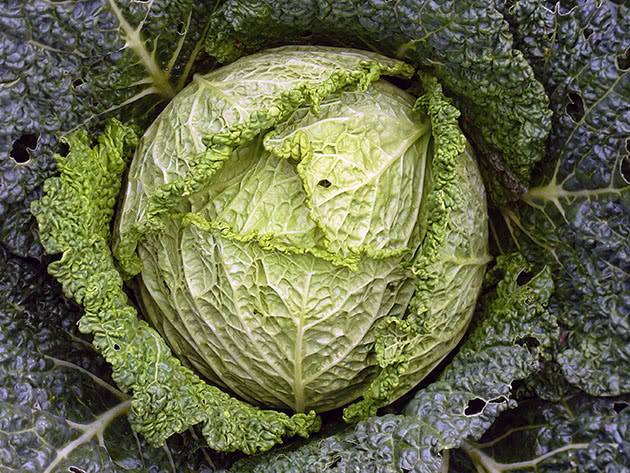
Planting the cabbage in the ground is preceded by a two-week tempering that aims to prepare the seedlings to grow under new conditions. The window should be opened for 3-4 hours in the room with seedlings for the first 2 days with the protection of seedlings from drafts. Then during a few days the seedlings are placed for an hour or two on the balcony to be exposed to the sun light, but the shoots should be protected from the direct sun light by being covered by the gauze. In a week you should reduce watering and place the seedlings on the balcony and keep them there until planting in the ground.
Cabbage planting in the open ground
When to plant cabbage in the ground
Planting the seedlings of early cabbage varieties in the open ground is carried out when the seedlings have 5-7 leaves and the seedlings height is up to 4.7-7.8 inches. To be planted in the ground the seedling of mid-season cabbage should have 4-6 leaves at the height of 5.9-7.8 inches. Usually the seedlings of early varieties achieve necessary parameters in early May, the late varieties have them from the middle till the end of May and mid-season varieties have them from late May till mid-June.

The soil for cabbage
Before planting the cabbage, it is necessary to prepare a site for it. It should be sun lighted from morning till evening. As for the soil, the early varieties of cabbage prefer loam and sandy soil, and mid and late season varieties prefer loam or clay soil. The pH of the sandy soils should be ± 6,0, and the pH of clay and sand or clay soils should be ± 7,0. Acidic soils are unsuitable for the cultivation of cabbage. You should not grow the cabbage on the sites affected by bacteriosis for eight years. It is undesirable to plant cabbages on the sites where other cabbage crops were grown not so long time ago – turnips, small radish, mustard, rutabaga or cabbage. A site where these crop were grown cannot be used for planting cabbage at least three years.
The soil on the site for the cabbage should be prepared beforehand starting from the first days of autumn preceding planting: in dry weather carefully dig site to a depth to which the spade will go, but do not try to level the surface, because the steeper the bumps are, the more moisture the soil can soak in winter and spring. After snow melting, you should do so-called 'moisture closing’ – level the soil surface by rakes to prevent too rapid evaporation of water from the soil. Very soon the weeds will appear that need to be immediately removed.
How to plant cabbage in the open ground
Scheme of seedlings planting in the open ground is approximately the following:
- 30x40 for hybrid and early varieties, 50x60 for mid-season varieties and 60x70 for late varieties of white and red cabbage;
- 30x40 for kohlrabi;
- 25x50 for cauliflower;
- 60-70 to Brussels cabbage;
- 40x60 for Savoy cabbage;
- 30x50 for broccoli.
Try not to thicken the beds because the cabbage needs a lot of light and space.
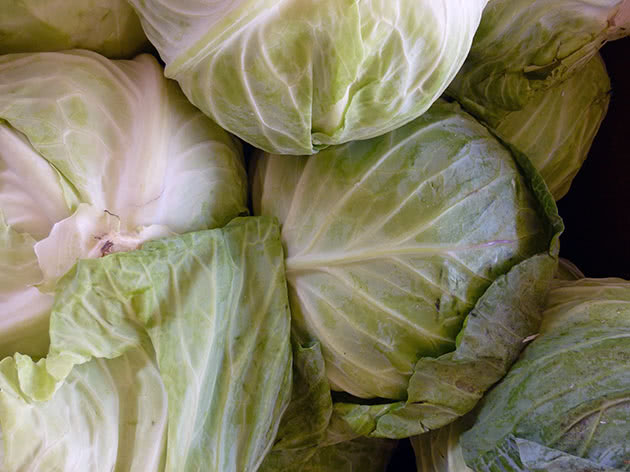
Make a hole in the ground a little more than the root system of seedlings with a clod of soil or peat humus pots. Put a handful of sand and peat into each hole, two handfuls of humus and 1.8 oz of wood ash, add a half of a teaspoon of nitrophosphate, abundantly water and mix it thoroughly. A clod of soil with the root system of the seedling is dipped directly into the liquid, sprinkled with damp soil, lightly pressed and a dry soil is added on the top. Too stretched seedlings are planted in such a way that the first pair of leaves is at the level of the ground surface.
Care for cabbage
How to grow the cabbage
For the first time, carefully observe the planted seedlings in order to put a fallen off seedling into the place in time. If sunny days are forecast, make a shade over the beds with the seedlings by newspapers or non-woven fabric. Within a week every evening you should water the seedlings from a watering can with a sprinkler, after that if no night frosts are expected, the cover can be removed. Further care for the seedlings in the open ground implies watering, hoeing the soil, weeding, regular fertilizing and treatment of cabbage from pests and diseases. In three weeks after planting, the cabbages is earthed up, and in 10 days the procedure should be repeated again.
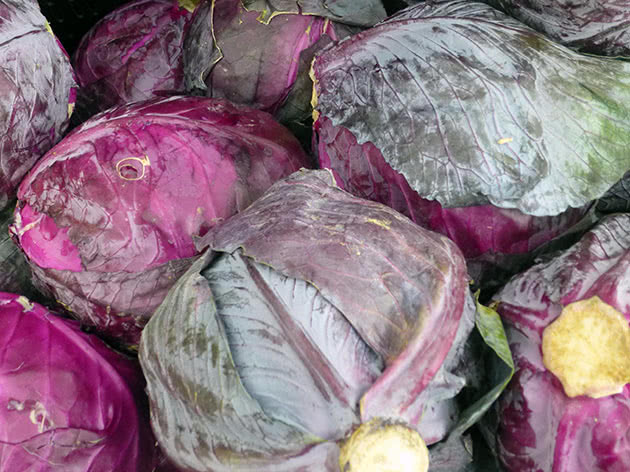
Cabbage watering
Growing cabbage in the open ground will require you to comply with strict irrigation regime, because the plant needs a lot of moisture. How to water a planted cabbage? Watering is carried out in the evening, a period of 5-6 days should be between abundant waterings in cloudy days, in hot weather it should be watered every 2-3 days. After watering you should loose soil on the site, while earthing up the cabbage. Professionals recommend using a mulch layer of peat 2 inches high – it better retains moisture in the soil and at the same time serves as food for the developing plant.
Feeding the cabbage
In 7-9 days after pricking out, seedlings need to receive the first dressing, consisting of 0.07 oz of potassium fertilizer, 0.1 oz of superphosphate and 0.07 oz of ammonium nitrate, dissolved in 1.75 pints of water – this amount should be enough to fertilize 50-60 seedlings. To avoid burns, cabbage fertilizing is carried out when the ground is preliminary watered. The second dressing is carried out two weeks later, and consists of the same fertilizers, but doubled in amount and dissolved in the same amount of water. If the seedlings turn slightly yellow, feed them with the liquid solution of fermented manure at the rate of 1:10. The third, the so-called hardening, dressing is carried out a couple of days prior to transplanting the seedling in the open ground, and it consists of 0.1 oz of ammonium nitrate, 0.3 oz of potassium fertilizer and 0.2 oz of superphosphate, dissolved in a 1.75 pints of water. A high concentration of potassium fertilizer promotes survival of seedlings in the open ground. If you do not have time to prepare nutritious mix, purchase a liquid combined fertilizer.
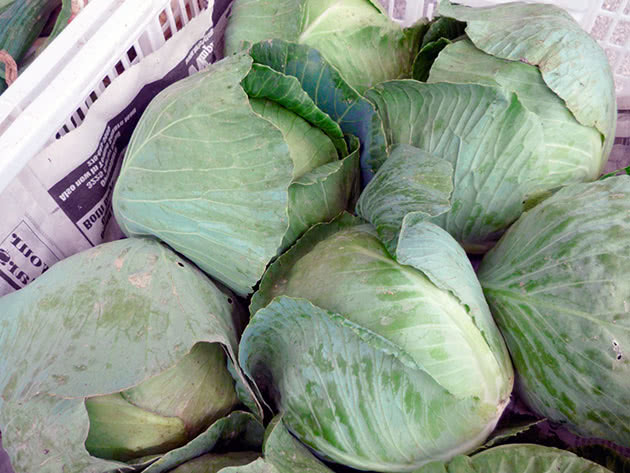
If you feed the cabbage at the stage of seedlings, its development should be fast and intense, but after planting in the open ground the cabbage feeding should not be ceased. How to fertilize cabbage when its leaves grow? It is better to add a solution of 0.35 oz of ammonium nitrate in 2.2 gallons of water into the soil. This dose should be enough for 5-6 plants. When the leaves begin forming the head, the second dressing is carried out with a solution of 0.14 oz of calurea, 0.17 oz of double superphosphate, and 0.28 oz of potassium sulfate in 2.2 gallons of water for the same amount of plants.
Treatment of cabbage
After planting in the open ground the seedlings are powdered with ashes with the addition of tobacco dust – this measure will protect the young plants from slugs and beetles. White cabbage is a food product, so it is very undesirable and unwise to use agricultural chemicals to control pests and diseases. How to process the cabbage to get rid off its enemies and at the same time not to poison the product you are going to eat? There are many ways to protect the cabbage from the invasion of aphids, caterpillars, larvae and gastropods – snails and slugs. Aphids and caterpillars can be destroyed by spraying with such infusion: 4.4 pounds of tomato foliage is filled with 3.5 pints of water, infused for 3-4 hours, then boiled for 3 hours, let it cool, filter and dilute it with water 1: 2. To make the infusion "stick" to the leaves, and not to flow down to the ground, add 0.7-1 oz of grated tar soap. You can use the infusion of onion peel in the fight against aphids and caterpillars: 1. 75 pint jar of peel is poured with 3.5 pints of boiling water and infused for two days, then filter and add another 3.5 pints of water and a tablespoon of liquid soap or dishwashing detergent.
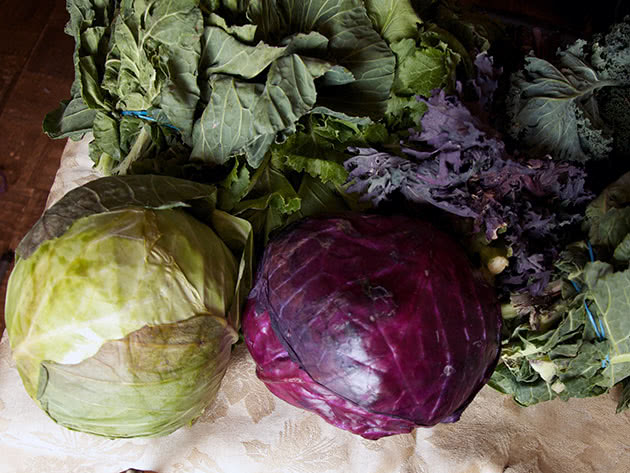
To fight against the larvae of the may-bugs, cutworms or cabbage fly, ants are attracted to the site by the jar with honey or jam diluted with water. The jar should be slightly immersed into the ground. Attracted by the sweets black ants will eat the larvae.
As a preventive measure in the fight against harmful insects, on the site with cabbage and around it you can plant marigold, mint, sage, coriander, basil, rosemary and other spice plants. Tart flavor deters aphids, moths, slugs, beetles and attract their eternal enemies to fight with them – ladybugs, lacewings and others.
Cabbage diseases
Some diseases of cabbage spread so fast that any delay can result in serious losses in the field. We'll tell you what diseases affect cabbage and how to treat cabbage to save the crops. One of the most dangerous plant diseases is a clubroot – a common fungal disease that affects early varieties of white cabbage and cauliflower at the seedling stage: the roots of seedlings develop the clubs (swellings) that harm the nutrition of young plants, seedlings lag behind in development – they do not even form the ovary. Remove diseased plants from the site, along with a clod of soil, and sprinkle the place where they grew up with lime. Growing of the cabbage at this place should be avoided for a while, but other plants can grow without any risk, as clubroot affects only cruciferous.

Very frequently the cabbage at the seedling stage or being already planted in the open ground is affected by blackleg. It is a fungal disease of the root collar at the base of the stem. These parts of seedlings get black, thin and start rotting. The plant growth slows down and it dies. Such seedlings are not planted in the ground as in any case they will die. The soil on the site with affected cabbage should be replaced since it is not suitable for growing cabbage. As a preventative measure, seeds before planting should be treated with a fungicide and the soil should be processed with pesticide in accordance with the instruction.
Sometimes cabbage can suffer from mildew – downy mildew. Usually, germs can be found in seeds, that's why a pre-sowing processing is so important. The disease manifests itself in wet weather by pale red and yellow spots on the upper surface of the cabbage leaves As a result of the disease leaves turn yellow and die. As a preventive treatment, seeds should be processed with fungicide. Good results are achieved through hydrothermal treatment – the seeds are soaked in hot water (122 ºF) for 20-25 minutes. If preventive measures were not taken, or they did not work, you can process the cabbage with the garlic decoction: add 2.6 oz of finely chopped garlic into 2.2 gallons of water, leave for 12 hours, then boil the mixture, let it cool and sprinkle the plants with it. If this measure fails, treat the cabbage with a fungicide. If necessary, treatment can be repeated in two to three weeks. But keep in mind that the fungicide can be applied before forming of the cabbage head, otherwise there is a risk of accumulation of toxic chemicals in the leaves.
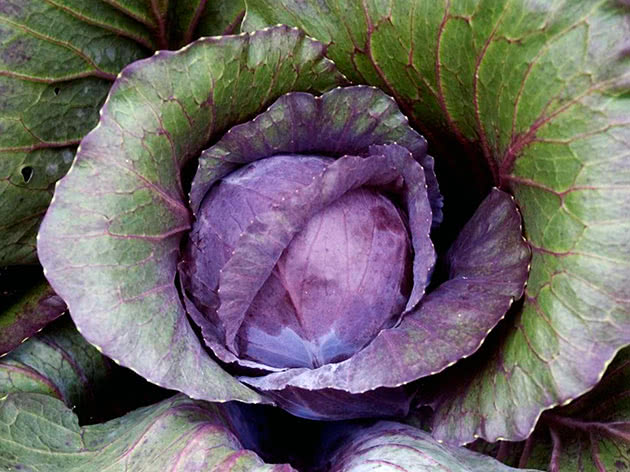
White and gray mold are also trouble-makers for gardeners. White mold occurs under the condition of low temperature combined with high humidity and manifests itself by appearance of mucus on the upper side of the cabbage leaves and between them there is a cotton-like white mycelium with black sclerotia from 0.04 to 0.1 inch in size. Affected by white mold cabbage rots in storage, contaminating adjacent heads of cabbage. Gray mold also manifests itself during storage: the petioles of lower leaves are covered with downy mildew and black beads. To protect the cabbage harvest from these diseases you should carry out pre-sowing disinfection of seeds, apply with agricultural principals, conduct preventive cleaning and disinfection of storage before placing cabbage harvest, comply with the rules of its storage, timely detect the disease and clean the affected areas.
Fusarium wilt or yellows is a very dangerous disease caused by the fungus Fusarium. The seedlings are affected in nursery stage, the death of young plants from this disease is sometimes 20-25%. Symptoms are the loss of leaves turgor and the appearance of yellow areas. Development of the leaf with yellowing slows down, sick leaves fall. To prevent the spread of the disease, the affected plants are dug out with roots and destroyed, the ground should be steamed or changed. Autumn and spring preventative treatment with a solution of copper sulfate (0.17 oz of the drug dissolved in 2.2 gallons of water) helps control the fungus.

Wire stem is another fungal disease of cabbage, occurring at strong temperature fluctuations (eg, from 37 ºF to 77 ºF), relative humidity (40 to 100%), soil acidity (pH value of 4.5 to 8 units). The disease affects the root neck making it yellow, it withers and dies, the roots turn into a washcloth and the plant dies. Infection occurs in the field, the disease continues to develop even in the storage. As a preventative measure, before cabbage planting the soil is processed with copper oxychloride or drugs that contain it.
Cabbage pests
The ways how to manage aphids, caterpillars, larvae and gastropods were described on the section on the cabbage treatment. But the plant has many enemies among insects, and in this section we will talk about how to get rid off other pests from the insect world. Serious enemies of cabbage are crucifer shield bugs – colorful bugs up to 0.4 inch in size, wintering in the soil. In late April they begin to eat seedlings, in early summer the females lay their eggs, in two weeks larvae appear, and a month later there are adult bugs. They eat cabbage sap, riddling its leaves with holes. The punctured place turns dead, and if there are a lot of such places, seedling leaves wilt, wither and die. Cabbage bugs cause the strongest harm during drought. As a preventive measure, cruciferous weeds should be removed from the site. They are summer rape, corn rocket, dish mustard, shepherd's purse, alyssum and watercress. After harvesting the cabbage you should not leave any weeds on the site, collect and burn them. Insecticides can be used as a treatment of cabbage seedlings before the formation of cabbage heads.
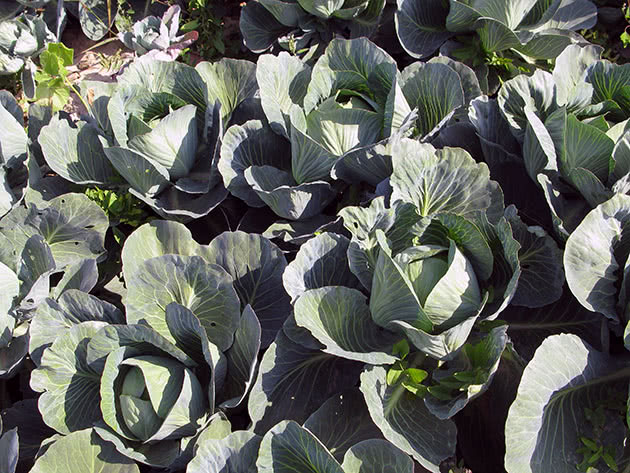
Cabbage leaf beetles are small egg-shaped beetle 0.2 inch long. They damage plant leaves, riddle them with holes or making holes along the edges of the leaves. Leaf beetles also overwinter in the soil, and in May the females lay the eggs and in 10-12 days the larvae appear that eat the leaves by scrapping its peel. As a preventive measure and as in the case of the fight against crucifer shield bugs, it is necessary to remove cruciferous weeds from the site. A daily morning spraying of the cabbage by a mixture of tobacco dust and ash or slaked lime in a ratio of 1: 1 can help manage the leaf beetles. Biochemicals or insecticides can be used prior to the formation of heads of cabbage.
Cabbage seed-stalk curculio is another cabbage enemy. It is a black beetle up to 0.1 inch long. The larvae of the cabbage seed-stalk curculio is dangerous as it burrows tunnels in the petioles, penetrating into the stem and down to the root of cabbage. At the same time the vascular system get damaged, the leaves turn yellow, the plants cease to grow and die. To control this pest it is very important to remove weeds from the site in autumn, and then dig over the soil. During the growing period timely weeding and removing plants affected by pest are also very important. You can chemically destroy the pest, but the insecticide treatment is permissible only at the early stages of development of seedlings in open ground.
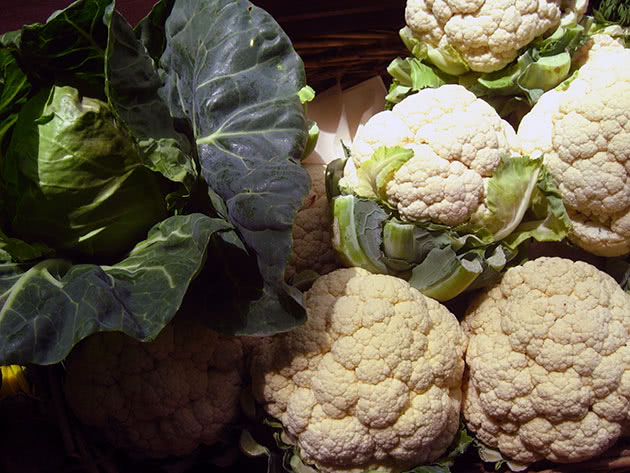
Collecting and storage of cabbage
Watering of cabbage should be ceased three week prior to its collecting. This measure stimulates the accumulation of fiber that contributes to the storage of cabbage. When the night temperature drops to 28 ºF, you can start harvesting. Do not procrastinate with the harvest, since at a lower night temperature the cabbage gets frozen that negatively affects its storage qualities. Dig out the cabbage with its root, sort it out, setting aside heads of cabbage that are small, affected by moth, beetle, or rot. This cabbage can not be stored, it has to be eaten or pickled. The heads of cabbage that are suitable for storage are piled under the canopy for a night, so that they get dried up, then the cabbage stalks are cut at 0.8 inch below the head of cabbage, leaving 3-4 covering green leaves. Now, the cabbage can be placed in the storage.
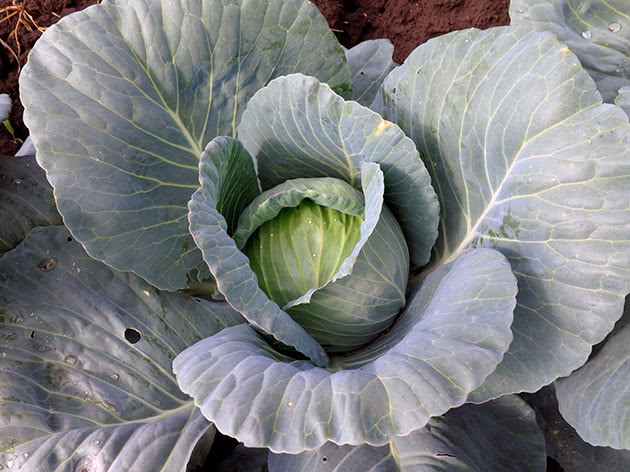
It is better to store vegetables in the cellar where, as a rule, there is a high humidity, and the temperature does not fall below 32 ºF. If in addition the temperature in the cellar does not get above 39-43 ºF in winter, it is almost an ideal storage for cabbage, since optimal conditions for storage of cabbage heads are temperature from 30 to 34 ºF and humidity of 90 to 98%. But at first you need to put things in order in the room: there should be no mold on the walls, despite the high humidity; there should be no garbage on the dirt or cement floor. It is desirable to process the walls with quicklime, and then sulfurise the cellar. You should provide a good ventilation. If there is no the ventilation system, you will have to ventilate a cellar at least once a month. The cabbage is stored by placing it in a single layer on the shelves, stacked up in pyramid on wooden boards or suspended and wrapped in a newspaper. For the cabbage to remain fresh as long as possible, the gardeners have some tricks that we are willing to share with you:
- you can link the cabbage in pairs by stalks and hang them on the ceiling poles. In this position the heads have access to air, they can be easily inspected in order to detect rot;
- the cabbage can be stored in lattice wooden boxes placed on a stand or on a shelf – the main thing is that they should not stand on the floor;
- wrapped in the paper the cabbage heads are placed in a plastic bag, without tying it, and hung up to the ceiling or placed on a shelf;
- a cabbage head is placed in a bucket with soil, then it is completely covered with soil and the bucket is placed in the cellar. You can use sand instead of soil.
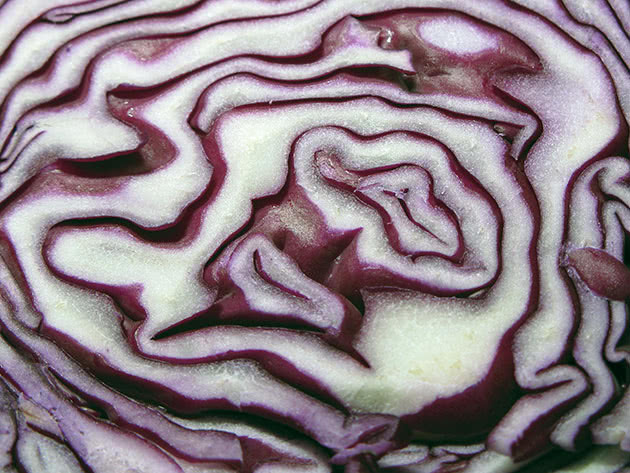
There are two more ways to store cabbage, but in this case cabbage stalks should not be cut off and covering the leaves should be removed on the contrary. After that, the heads of cabbages are hung in a draft and slightly dry-cured. When the upper leaves dry out, cabbage heads are moved into the cellar, and bound two by two, hung by roots to the ceiling. Or cabbage head is immersed into a clay mash of a consistency of dough for pancakes (cabbage leaves should not be seen through the clay layer), then let the clay dry with head hanging, and place it in the cellar, where it should be also hung to the ceiling. We have described you the storage of white and red cabbages. Cauliflower is stored only in a suspended state with head wrapped in paper.
Surely, you can keep the cabbage in the refrigerator, wrapped in a paper towel and placed in a loosely tied package, but in the vegetable drawer there is no so much space, and the cabbage can be stored in the refrigerator no more than two months.
Species and varieties of cabbage
Different species and varieties of cabbage are grown both industrially and in private gardens, as this vegetable, like potato, is one of the most basic. We offer you the species of cabbage for growing in open ground that you can grow at home, or near the house if desired.
White cabbage
In our area it is one of the most widespread species. It forms a short thickened stem, covered with leaves of large size, as well as the head that is the apical bud that grows to enormous proportions. Some cabbages are 2.5 stone, they are round and dense. It contains fiber, carotene, vitamins C and B. It is widely used in folk medicine for diseases of the stomach and swelling. It is used externally to cure suppuration and skin boils. Yields of cabbage, as well as its size, depend on its variety: the most productive varieties are Gribovsky and June (early-season), Gift and Glory (mid-season), and Moscow Late and Amager (late-season).

Red cabbage
in many ways is similar to white cabbage, but it is more frost-resistant. Its leaves are purple rather than red, cabbage head weighs up to 11 pounds. It is characterized by high density, therefore, it is kept longer. The red cabbage has twice less fiber than white cabbage, but it contains four times more carotene. It also contains iodine, mineral salts, pantothenic acid, iron, cyanidin that strengthens the walls of blood vessels. The most common varieties are Gako, St. Michael, Stone Head.
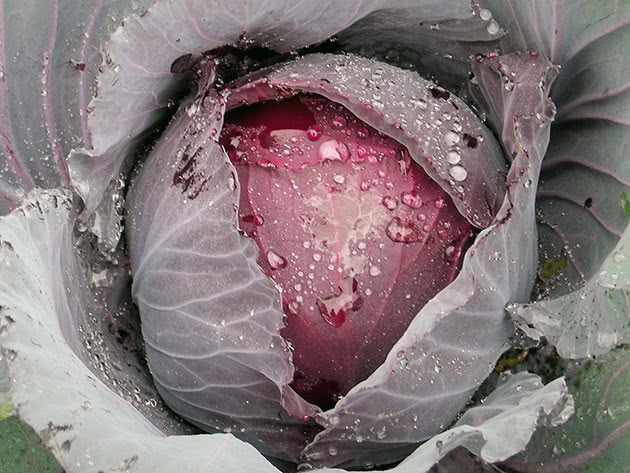
Cauliflower
is a dietary product that is a creamy grainy lumpy hemispherical head surrounded by green leaves and weighs up to 2.2 pounds. It consists of almost merged together rudimentary flowers on branched short stalks. The most commonly grown varieties are Movir, Early Gribovskaya, Guarantee (early season), Moscow Canning, Patriotic (mid-season), Adler Winter (late-season).
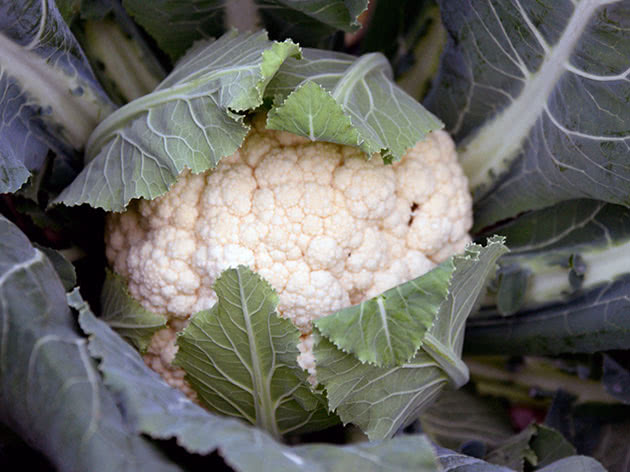
Broccoli
is a kind of cauliflower, its head consists of green and purple inflorescences. It contains high level of mineral salts of potassium, magnesium, phosphorus, calcium, vitamins C, A, B1, B2, PP. It has an antioxidant action, useful as prevention of cardiovascular diseases and cancer.

Brussels sprouts
look like a long stalk with lots of miniature cabbages, similar to the heads of white cabbage. Brussels sprout contains more vitamin C than citrus fruits, it has lots of protein, magnesium, phosphorus and folic acid. It increases the body's resistance to disease, improves mental activity.

Savoy cabbage
has a form of white cabbage, but its gentle strongly corrugated bright green leaves are rolled into a loose head. This species contains more protein and vitamins than white cabbage.
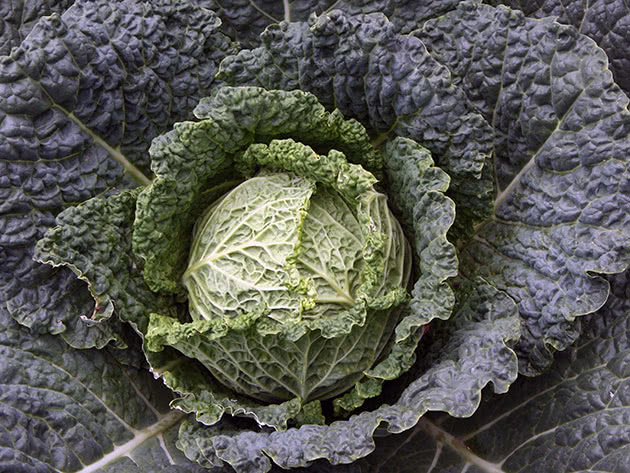
Kohlrabi
looks like a globular stem with leaves on long stalks. It contains a large amount of protein and vitamin C, glucose and calcium.

Pekinensis cabbage
is a very popular edible product today. Its head is long, flabby, fiber is gentle and has pleasant taste. The leaves contain a lot of nutrients, but its main advantage is that vitamin C is preserved during storage.
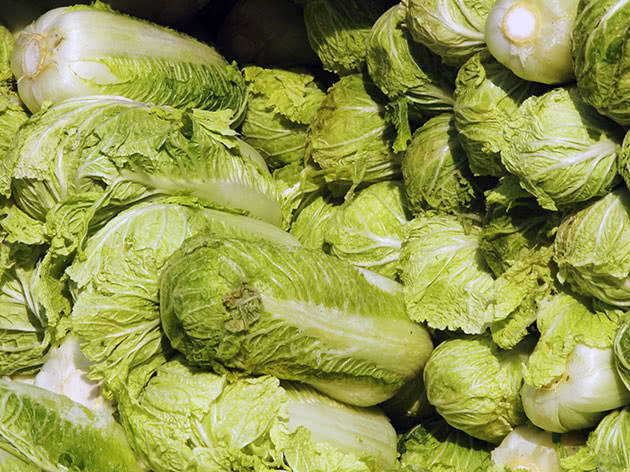
Chinensis cabbage
is a leafy vegetable that does not form a head of cabbage. It looks like a salad, but its structure is close to the cabbage. It contains the essential amino acid lysine, cleansing the body from toxins and improving immunity. Chinensis cabbage is considered a source of longevity.
